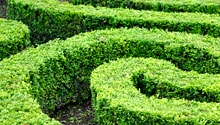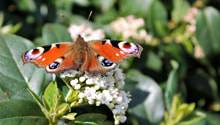Nearly all of our hedging plants will grow in partial shade and it’s very much the minority that cannot survive without sunshine, but there are some that perform well and some that will just tolerate shade. If shade is caused by overhanging trees, there can also be dry soil and this can cause as many problems as the shade. It is sensible in this instance to use
RootGrow when planting to ensure that new planted hedging can reach what moisture there is in the soil and you need to be very diligent with the watering (really drench the plants occasionally to encourage the roots to go down deep to find moisture).
The best performers in shade tend not to be flowering species and since many berries are formed from flowers, that means that most will not produce berries, though there are exceptions and some species will flower and produce berries in shade.
Our top five hedge plant recommendations for shade or partial shade are:
- Cherry Laurel (Prunus laurocerasus) – one of our best selling hedging plants and good in shade – it’s evergreen, fast growing and has glossy bright green leaves which help to brighten a shady area
- Yew (Taxus baccata) – a super quality dense dark green species which really likes shady areas – quite slow growing
- Pyracantha (Firethorn) – prickly evergreen which normally produces profuse flowers and berries – Pyracantha will grow well in partial shade (not full) but flowering and berrying will not be so profuse in this circumstance, however it’s still a good option – fast growing
- Holly (Ilex aquifolium) – another species which is really well suited to shade and will produce berries – prickly and evergreen and quite slow growing
- Cotoneaster franchetii (Franchet's cotoneaster) – one of the few flowering species which will perform in shade – this species has sage green leaves and pretty pink/white flowers like pearls and plenty of red berries – average growth rate
Others which are well suited to shade are:
Berberis ottawensis AuricomaBerberis stenophyllaBox (Buxus sempervirens)
Cotoneaster horizontalis (Wall cotoneaster)
Cotoneaster lacteus (Late cotoneaster)
Euonymus fortunei 'Emerald 'n' Gold' HedgeFlowering Currant (Ribes sanguineum)
Hornbeam (Carpinus betulus)
Hypericum 'Hidcote' (St John’s Wort)
Portuguese Laurel (Prunus lusitanica)
Bay Laurel (Laurus nobilis)
Lonicera pileataOleaster (Eleaegnus x ebbingeii)
Privet - Green (Ligustrum ovalifolium)
Western Red Cedar (Thuja plicata 'Atrovirens')
In addition there are also a number of species that are fine in pretty heavy partial shade:
Alder (Alnus glutinosa)
Bamboo - Green (Phllostachys-bissettii) - also available in
Black,
Golden and
Umbrella Bamboo varieties
Beech - Green (Fagus sylvatica)
Blackthorn (Prunus spinosa)
Dogwood (Cornus) - Click to read our guide on all varieties of Dogwood
Elder (Sambucus nigra)
Escallonia - Click to read our guide on all varieties of Escallonia
Euonymus 'Kathy'Euonymus japonicus 'Ovatus Aureus'Field Maple (Acer campestre)
ForsythiaHawthorn (Crataegus monogyna)
Hazel (Coryllus avellana)
Holly - Silver (Ilex aquifolium 'Argentea marginata')
Juneberry (Amelanchier lamarckii)
Laurel - Spotted (Aucuba japonica 'Crotonifolia')
Lonicera nitidaMonterey cypress 'Goldcrest'Mexican Orange Blossom (Choisya ternata)
Photinia 'Red Robin'Potentilla Pink (Also available in white, orange and yellow flowering varieties)
Privet - Wild (Ligustrum vulgare)
Prunus x cistena (Purple Leaf Sand Cherry)
Rowan or Mountain Ash (Sorbus acuparia)
Sea Buckthorn (Hippophae rhamnoides)
Viburnum opulus (Guelder Rose)
Viburnum tinusWillow (Salix capraea)































